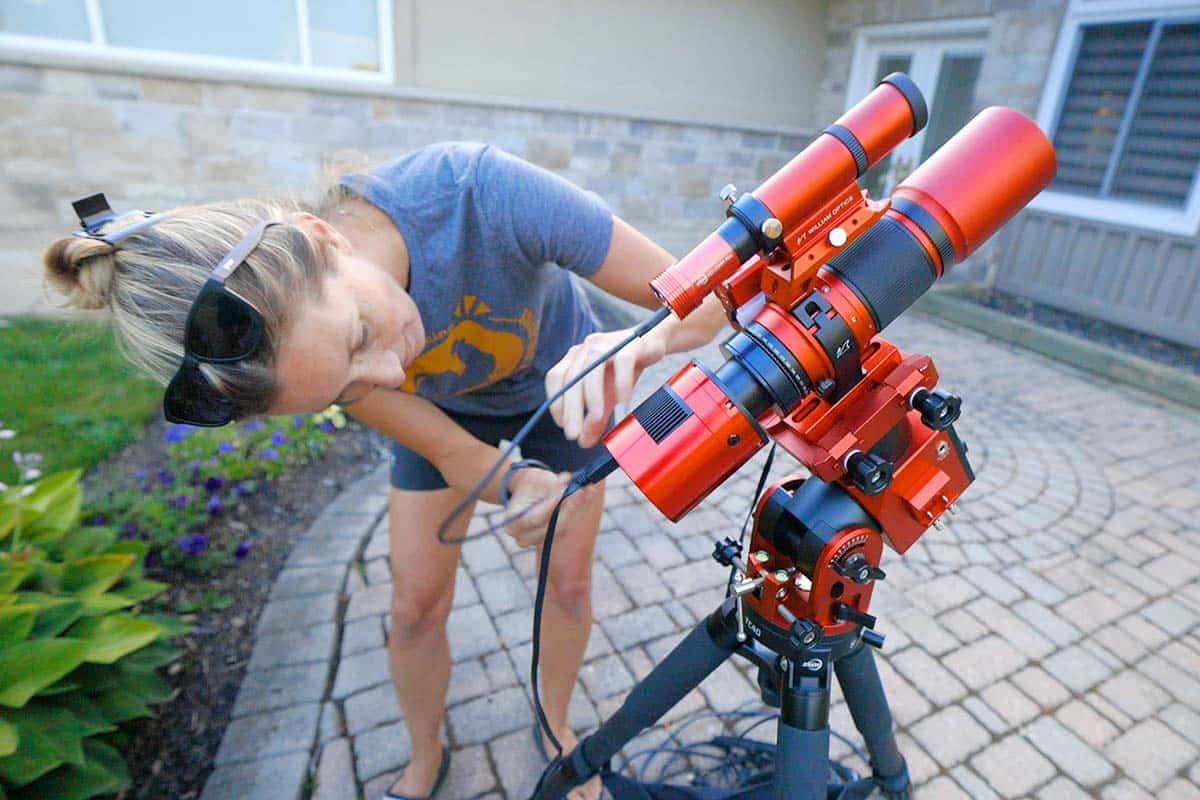Is A Full-Frame Camera for Astrophotography Worth It?

A full-frame camera has a larger image sensor, which means you can capture a wider field of view through your telescope or lens. This can help you create larger astrophotos, (in terms of both image resolution in pixels, and file size).
While it might seem like upgrading from a crop-sensor camera to a full-frame model is a no-brainer, there are some drawbacks to consider. This includes everything from the added cost of the camera to incompatibility issues with your current gear.
There is a big difference in the field of view captured with a crop sensor camera compared to a full-frame.
A larger sensor allows you to take advantage of the native focal length of your telescope or lens without cropping any of the image away. However, to fully utilize a large image sensor your optics (including optical filters) must be up to the task.
For most amateur astrophotographers, a crop sensor camera makes a lot more sense in terms of cost and compatibility with their existing equipment. Large filters and a telescope with a full-frame image circle are necessary to fully utilize a full-frame astrophotography camera.
Crop sensor CMOS sensors are found in most entry-level DSLR and Mirrorless cameras. (Canon EOS Rebel XSi).
Upgrading to Full-Frame
If you are looking to buy a new astrophotography camera, you may be wondering whether it is worth it to invest in one with a full-frame camera sensor. While it may seem like an obvious choice for those who can afford it, the decision to upgrade to a larger sensor comes with several new challenges.
As with any big upgrade to your astrophotography equipment, compatibility, and desired user experience must be factored in before taking the plunge. The necessity for larger filters, a telescope with a large image circle, and an unforgiving sensor plane (tilt) are just a few of the potential issues that may arise.
Ashley using a full-frame ZWO ASI2400MC Pro color camera on the William Optics RedCat 51.
When these issues are addressed, you can enjoy the native focal length of your telescope or lens, and capture beautiful, massive images. As someone who has tested countless cameras to capture the night sky, I am in the unique position to offer you some sound advice based on experience, not theory.
With that being said, I have some advice for those thinking about upgrading to a full-frame camera for astrophotography. For a complete overview of the gear I use to capture deep-sky images, please visit the astrophotography equipment page.
Astrophotography Camera Sensor Sizes
Over the last 10 years, I have used many cameras for astrophotography, from tiny planetary imaging cameras to several full-frame CMOS cameras (mono, one-shot-color, mirrorless).
These days, I bounce around between a full-frame ZWO ASI2400MC Pro (color), and a ZWO ASI2600MM Pro (mono) for almost every astrophotography project I take on.
The difference in sensor size between a crop sensor and a full-frame astrophotography camera.
While a larger image sensor may seem like an obvious advantage, remember that this camera will be much more unforgiving to the optics you pair with it. Only the best astrophotography telescopes will deliver a sharp, flat field with a full-frame camera attached.
You also need to think about the larger filters you will need to use with a full-frame sensor, which can increase your overall cost of upgrading even more. As you can see, this decision involves a lot more than just the price of the camera itself.
Whether you are looking into buying a full-frame astrophotography camera like the Canon EOS Ra, or even a cooled monochrome dedicated astronomy camera, I think this article will help you make a decision.
My Canon EOS Ra astrophotography camera uses an astro-modified full-frame sensor.
Astrophotography Camera Sensor Sizes
If you began your astrophotography journey with a DSLR or mirrorless camera, chances are it was either an affordable crop-sensor (APS-C) camera body. If you were serious about photography, maybe you even started out with a full-frame DSLR.
These are the 2 primary sensor sizes in today’s professional photography cameras, and they are now quite typical in astrophotography cameras as well. Not too long ago, dedicated astronomy cameras used much smaller sensors.
In the dedicated astronomy camera world, an APS-C sensor is still considered to be quite large. They cover a large field of view, yet do not require extra large astronomical filters and full-frame compatible telescopes.
Crop Sensor Cameras
A great example of a camera in this category the crop sensor format is the popular ZWO ASI2600MM Pro. It features a sensitive monochrome CMOS sensor in a cooled camera body.
If the field of view is too narrow for you, you could always capture a high-resolution mosaic image of a particular target to cover the whole thing. This will require a little more work, but it can provide some incredible results.
If you’re more into astrophotography with a camera lens, a Canon EOS Rebel T8i is a great choice for a beginner.
Full Frame Cameras
The full-frame astrophotography cameras I use most are currently the Canon EOS Ra, and the ZWO ASI2400MC Pro. The Canon EOS Ra is an astro-modified mirrorless camera body, while the ASI2400MC Pro is a one-shot-color camera.
Both of these cameras can capture images at the native focal length of my telescopes without cropping the field of view. When shooting Nightscapes or the Milky Way with a camera lens, I always use the mirrorless Canon EOS Ra rather than using an adapter with the astronomy camera.
Images captured using a full-frame camera are larger than ones using a crop-sensor, which increases file size, and image stacking time. The larger ASI6200MM Pro is used less, because I do not own filters large enough to fully utilize the sensor.
I currently use 2 dedicated astronomy cameras, the ZWO ASI2400MC Pro (color), and the ZWO ASI6200MM Pro (mono).
Using a Full-Frame Camera for Deep-Sky Objects
If you have decided to go with a full-frame camera for astrophotography, and you have sorted out any potential issues, you can enjoy a massive field of view from your telescope.
This is especially beneficial when capturing large deep-sky objects such as hydrogen emission regions in the night sky. Certain objects (the North America Nebula, for example) are massive in size in terms of arc seconds (120 x 100 arcminutes).
The image below shows the Heart and Soul Nebulae captured using a full-frame astrophotography camera (Canon EOS Ra) and a 61mm refractor telescope with a focal length of 275mm.
The Heart and Soul Nebulae. Canon EOS Ra, Radian 61 APO.
The Andromeda Galaxy. ZWO ASI2400MC Pro, William Optics FLT 132.
Certain telescopes perform better than others with a full-frame camera. To increase your chances of compatibility, make sure that the telescope has an image circle of 46mm or larger, and that you are using the dedicated field flattener if it needs one.
Things to Consider:
- Price of filters and performance
- Price of a filter wheel
- Telescopes with a full-frame image circle
- Image tilt, flexure (focuser stability)
- Vignetting
- Increased File Size
Nightscapes and the Milky Way
A full-frame camera is also great for Nightscapes and Milky Way Photography, especially when paired with a fast camera lens. The wider field of view (when paired with a wide-angle lens) is a little more forgiving in terms of star trailing when using a stationary tripod.
If you’re mostly interested in landscape astrophotography images using a camera lens, I highly recommend using a mirrorless camera over a dedicated astronomy camera. These camera bodies have the features and control you need to make the most of your dark sky excursions.
The following image was captured using a Sigma 24mm F/1.4 art series lens on a star tracker.
The Milky Way using a full-frame mirrorless camera and 24mm lens.
If you are familiar with daytime landscape photography, you’ll know how beneficial a camera with a large image sensor can be. You can capture more of the scene at once, and have more options in terms of composition and framing.
The same benefits apply when you are taking pictures at night. While you can always create a mosaic using a crop sensor camera, this requires more work and can be tricky to get right.
The Orion Constellation. Canon EOS Ra, Sigmas 24mm F/1.4.
The bottom line is, if nightscapes are what you’re most interested in, a full-frame DSLR/mirrorless camera is ideal. Unlike most astronomical telescopes, full-frame compatible camera lenses were designed to fully illuminate the sensor.
Understanding Image Scale
The image scale of your image refers to the relation between the pixel size of your camera sensor, and the focal length of your telescope. It provides a value in arc seconds per pixel, which is essentially the area of sky each pixel collects at a time.
The ideal image scale range is about 1.0-2.0 arcseconds per pixel. This image scale range produces images with pleasing star shapes (round), and an image that is not too sharp or soft. Just right.
You can use the simple formula below to calculate the image scale of your camera and telescope combination. Pixel size divided by focal length, multiplied by 206.
For example, let’s say I am using the ZWO ASI2400MC Pro camera with pixels that are 5.76 um in size, and I have it attached to my Sky-Watcher Esprit 100 Telescope with a focal length of 500mm.
This system has an image scale of 2.1. Of course, this is just a starting point for your image data, as you may choose to sharpen/soften the details in your image substantially in post-processing.
Your camera and telescope’s image scale will determine the overall look of your images.
Is a Full-Frame Camera Worth It?
If you own a high-quality astrophotography telescope with a full-frame image circle (at least 46mm), you can enjoy incredibly large format images that use your telescope’s native focal length. However, most telescopes that advertise being ‘full-frame’ compatible will still not look perfect to the edge of the field.
This seems to be the case even when the dedicated field flattener is used. As mentioned earlier, even minor issues in tilt may become worse, and vignetting will come into play.
If you are okay with cropping the image by up to 10%, this shouldn’t be an issue for you. However, many people will want to maximize the entire full-frame sensor from edge to edge, and this may lead to expensive equipment upgrades.
A 2″ (48mm) round-mounted filter will cover most of a full-frame sensor, but you will likely see substantial vignetting around the edges of the frame. To fully cover a large full-frame sensor, you may need to invest in larger (50mm) astronomical filters which can be very expensive.
Take a look at the image below taken with a full-frame dedicated astronomy camera and a 2″ filter. In this case, the telescope (Sky-Watcher Esprit 150) was able to accommodate the large sensor, but the filter was not.
A 48mm round-mounted Optolong L-eXtreme filter is not big enough to cover the large full-frame image sensor.
If you are using a full-frame or mirrorless camera for astrophotography, a great option is the clip-in-style filter. These fully cover the sensor and avoid scenarios like the example above.
If you plan on shooting broadband images without the use of a filter, this is less of an issue. In the example below, you’ll see how great the optical field looks on the RedCat 61 with a full-frame image sensor.
Use Aberration Inspector in PixInsight to diagnose issues such as tilt and vignetting. (Redcat 61 + Full-Frame Camera).
All telescopes are not created equal, and some will be up to the task of a full-frame camera, while others are not. Upgrading to a full-frame astrophotography camera is the ultimate test of your telescope or lens’s optical performance, so be ready to deal with the results.
If you are most interested in capturing deep-sky objects through a telescope using filters, I think a crop-sensor camera like the ZWO ASI2600MM Pro (or similar) is best. The sensor is large enough to capture a wide field, yet in a practical size that won’t force you to upgrade every other piece of your imaging train.
The ZWO ASI2600MM Pro (crop sensor) is a practical camera choice in 2024.
Trevor Jones




















Great write up and insights about full-frame versus crop sensors. I recently pulled the trigger on my third new rig (SCT) in the last 9 months—my wife says she’s going to send me to Astrophotographers Anonymous—and seriously considered the 6200MM. The camera, filter wheel, and 2” filters convinced me otherwise, bringing the entire kit to $22,000 USD.
I currently own the 2600MC and MM, and soon, whenever it’s back in stock, the Duo. I’m hoping I can get away without the OAG on an Edge Hd; we’ll see…
Thanks, as always!
Great article, Trevor! I didn’t realize the 2″ filters would have vignetting with a full-frame! Optolong has a few on-lens options for 77mm width lenses. One is for sky glow and one is actually the L-Pro. Will definitely utilize those for wide-field. I tried the clip in one for crop sensors but didn’t like that it wasn’t secured and kind of flopped around.
Thanks Brandon! I am interested to try out some of the on-lens astrophotography filters in the future.
Hi Trevor,
Great Website and info.
My question for astrophotography starts with How to plan a particular deepsky shoot . Determining 1. exposure times 2. gain. 3. Flats,darks etc. Filters
combinations. I am using ASI Air Plus – ASI 533 pro Mono – Ha, Sii, Oiii filters ASI 120 on OAG Sharpstar 94 triplett with F4.4 reducer/flattener.
A brief outline might help.
Thanks for all the great work you do with Astronomy.
It’s good to have someone lay out the pros and cons of full frame cameras. There are so many things running through my mind when making purchases that it’s easy to go down a rabbit hole.
Trevor, what are your thoughts on going to a full frame DSLR? Like from a Rebel T7 to the 5D Mark III or 6D? This is used with the Canon 200mm L series II lens, no telescope.
Michele – a full frame DSLR is a game-changer for astrophotography. If it’s in your budget, you will love the 5D III or 6D. Ashley and I shoot most with a Canon EOS R, and all my videos are filmed with an R6. You will enjoy fully utilizing the native focal length of your 200mm lens!